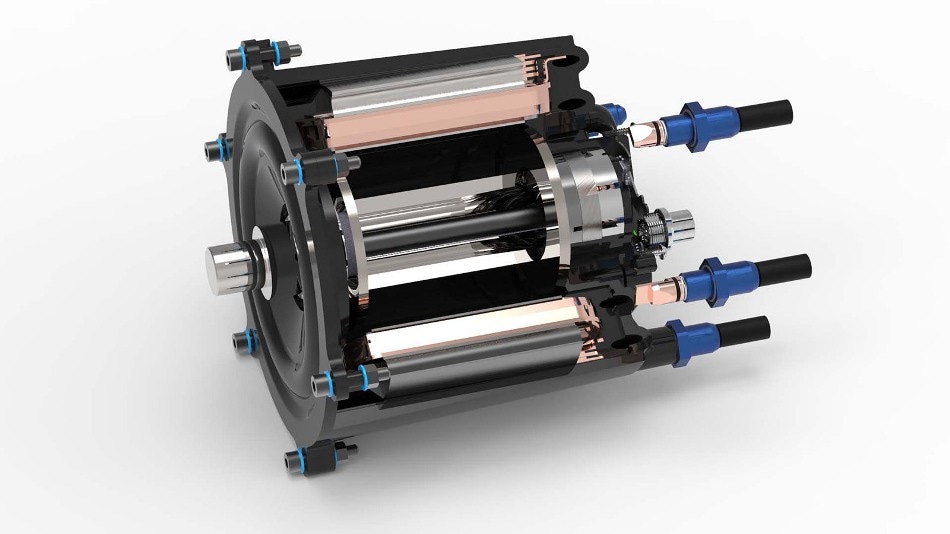Feb 4 2019
When it comes to making lighter electric cars, the weight of the motor also needs to be reduced. In this context, fabricating the motor from fiber-reinforced polymer materials provides one way to achieve that.
 Sectional view of the electric motor. The core of the motor is a stator consisting of twelve individual teeth, which are wound upright using a flat wire. (Image credit: Fraunhofer ICT)
Sectional view of the electric motor. The core of the motor is a stator consisting of twelve individual teeth, which are wound upright using a flat wire. (Image credit: Fraunhofer ICT)
Now, a research team at the Fraunhofer Institute for Chemical Technology ICT and the Karlsruhe Institute of Technology (KIT) is jointly working to create a novel cooling concept that will enable using polymers as motor housing materials. In addition to this, the new cooling concept also provides another benefit—it considerably boosts the motor’s power density and efficiency when compared to the state-of-the-art equivalents.
An electric drive train includes two major components—the battery and the electric motor. Whenever an electric motor is used for eco-friendly mobility, there are three problems that specifically play an integral role. These include high levels of efficiency, high power density, and a compact configuration that fits neatly inside the electric vehicle.
In association with the Institute of Electrical Engineering (ETI) and the Institute of Vehicle System Technology (FAST) at KIT, Fraunhofer ICT researchers in Pfinztal are currently working to create a new method that integrates direct cooling of the rotor and stator. This work is being done as part of the DEmiL project—a German acronym that stands for directly-cooled electric motor with integrated lightweight housing.
An electric motor consists of a rotating rotor and a static stator. The stator contains the copper windings that the electricity flows through—and this is where the majority of electrical losses occur. The novel aspects of our new concept lie in the stator.
Robert Maertens, Researcher, Fraunhofer ICT
Rectangular flat wire replaces round wire
More than 90% high efficiency is exhibited by electric motors, implying that a high amount of the electrical energy is transformed into mechanical energy, while the remaining electrical energy, that is 10% or so, is lost as heat. To make sure that the motor does not overheat, the heat within the stator is presently conducted to a cold water-filled cooling sleeve through a metal housing. In this research, the round wire has been replaced with a rectangular flat wire that can be coiled more tightly in the stator, producing extra space for the cooling channel beside the flat wire winding phases.
“In this optimized design, the heat losses can be dissipated through the cooling channel inside the stator, eliminating the need to transport the heat through the metal housing to an exterior cooling sleeve. In fact, you no longer need a cooling sleeve at all in this concept. It offers other benefits, too, including lower thermal inertia and higher continuous output from the motor,” stated Maertens, elucidating some of the benefits of the novel system. The latest design also integrates a rotor cooling solution that, in turn, enables the rotor’s heat loss to be directly dissipated inside the motor.
When the project partners dissipated the heat close to where it is produced, they were able to develop the entire housing and motor from polymer materials, which resulted in additional benefits.
Polymer housings are lightweight and easier to produce than aluminum housings. They also lend themselves to complex geometries without requiring post-processing, so we made some real savings on overall weight and cost.
Robert Maertens, Researcher, Fraunhofer ICT
Presently, the metal needed as a heat conductor can be substituted by polymer materials, which in comparison to metals possess a low thermal conductivity.
Fiber-reinforced, thermosetting plastics were eventually selected by the project partners because they have high resistance and high-temperature resistance to aggressive coolants. Thermosets are different from thermoplastics and do not swell upon coming into contact with chemicals.
Suitable for large series production
An automated injection molding process is typically used to produce the polymer housing. At present, it takes a cycle time of four minutes for creating the prototypes. Using a thermally conductive epoxy resin molding compound, the stators themselves are over-molded in a transfer molding process. A design and manufacturing process has been selected by the researchers to produce the electric motor at a massive scale. In addition, the team has experimentally confirmed the cooling concept and has already done the stator assembly.
“We used an electrical current to introduce the amount of heat in the copper windings that would be generated in real operation according to the simulation. We found that we can already dissipate over 80 percent of the expected heat losses. And we already have some promising approaches for dealing with the remaining heat losses of just under 20 percent, for example by optimizing the flow of coolant. We are now at the stage of assembling the rotors and will soon be able to operate the motor on the test bench at the Institute of Electrical Engineering and validate it in real operation,” stated Maertens, summarizing the current status of the project.